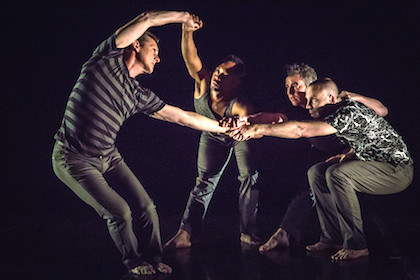The latest dance-theater work by Sean Dorsey Dance is The Missing Generation, a collection of pieces about survivors of the AIDS epidemic. In researching the work, Dorsey, a transgender artistic director and choreographer, interviewed survivors across the United States, and many of those oral histories can be heard in the show’s score. The Missing Generation will be performed through 2017 in numerous cities. Dorsey took a few moments from his travels to tell POZ about the show.
Why focus on the early days of AIDS?
Our culture has really turned its back on the early epidemic. I started this project thinking I’d be talking and choreographing about those we lost during those horrific early years. However, I realized that my calling was to attune and attend and give voice to a forgotten generation of survivors—an entire generation missing our attention and love and healing. This is my love letter to them.
What recurring topics emerged from your research and interviews?
I recorded 75 hours of conversations. These life stories came from many different communities: people of color and mixed race and white people; transgender women, gay men, bisexual men, queer and lesbian women, straight women, trans men. These distinct experiences and vantage points are an important aspect of the show. For example: As a transgender person, it was very important to me to bring in and center transgender experiences of the epidemic because transgender women have been completely erased from AIDS history, excluded from research and advocacy and much, much more.
But every person also spoke directly to many common experiences: growing up feeling different and alone, yearning for love and connection, moving to a new city to find community, the terror of the early years, the power of touch and community and rage and activism, the endless grief, the healing potential of love. Those are the threads that run through the show and that connect us all.
What amazed me most were the strength and resiliency and humor and love and power of people who have been through unspeakable trauma, horror, mass death and unimaginable grief. That was one of many great blessings about doing this work.
How are audiences responding to the show?
The audience response has been extraordinary, overwhelming, deep. Long-term survivors have come to me in tears, just hugged and held onto me and expressed their gratitude for giving a voice to this generation. I feel absolutely humbled and blessed to be doing this work.
In terms of documenting HIV history, what does dance offer that’s different from, say, books or film?
Dance is totally visceral: It is the physical embodiment of story, emotion, memory, grief, love and relationship. Like the human experience, it is a jumble of body and breath and story and emotion; like the human body, it is heartbreakingly ephemeral and will have an end.
Modern dance has such a reputation of being inaccessible and irrelevant. Most people feel like, “I don’t ‘get’ modern dance.” My job as a dance artist is to create dances that are well-crafted to be not just beautiful, but also accessible and relatable and relevant. This means that my dances can then have a deep impact on my audience. People feel and learn a lot during this show.
Don’t Miss a Beat
Sean Dorsey Dance gives voice--and much love--to a forgotten generation of AIDS survivors, including transgender people.










2 Comments
2 Comments